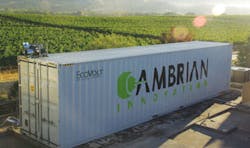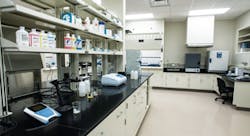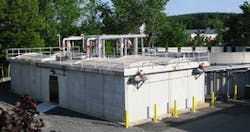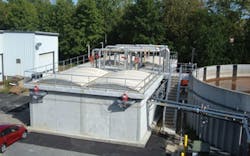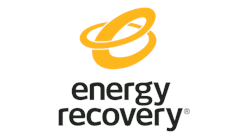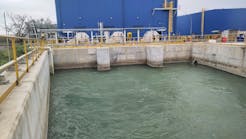Waste to Energy: Focus on Sustainability Drives Water Treatment Innovations in Food and Beverage Industry
By Jeff Gunderson
Water availability, tighter environmental regulations and growing interest in sustainability are pushing advancements and greater implementation of water treatment innovations in the food and beverage industry. As more food and beverage manufacturers look to adopt more environmentally responsible approaches and minimize operational risks -- including those related to waste disposal, wastewater discharge and rising energy costs -- advanced treatment processes including waste-to-energy projects are increasingly emerging as more viable alternatives.
According to a Frost & Sullivan analysis, the global food and beverage industry is under mounting pressure from growing populations and widening water scarcity and is being forced to reassess its water management strategies and embrace more modern treatment solutions. These trends are driving a fast-growing and future-
oriented water and wastewater treatment market that is inclined towards innovations and technological upgrades related to sustainable water management.
The analysis, which covered the food and beverage industry's increasing focus on water footprint and sustainability, also found that rising costs associated with process water requirements and wastewater discharge tariffs are influencing the adoption of advanced water treatment solutions, including closed-loop systems for water reuse and energy recovery.
Large amounts of water are required in food and beverage manufacturing, and wastewater generated from process operations is generally characterized as high-strength organic, with fats, oil and grease (FOG), suspended solids and high biological oxygen demand (BOD). While food and beverage wastewater can be complex and highly variable, the high-strength organic qualities also present the opportunity to implement anaerobic digestion treatment processes for recovering energy.
The potential to generate energy and reuse treated effluent is emerging as a key trend in food and beverage, largely driven by environmental and sustainability considerations, said Mitch Laginestra, service line leader for industrial water and waste management at engineering, architecture and environmental consulting company GHD. "Being biodegradable, food and beverage high-strength wastewater is not particularly difficult to treat, but because the wastewater characteristics differ significantly between food and beverage sectors, there is no distinct treatment solution."
Although traditionally the industry has been reluctant toward developing energy generation and water recycling due to lengthy investment payback periods and the requirement of skilled operators, costs associated with cogeneration systems have been decreasing, making these investments more attractive, said Chris Hertle, global market leader for the water sector, also with GHD.
According to Hertle, a number of new treatment processes are becoming available and include anaerobic membrane bioreactors; small-footprint granular aerobic systems; struvite removal systems for phosphorus recovery; and high-rate anaerobic systems for solids and fatty wastewaters; as well as the new Anammox technology for low-energy nitrogen removal.
BIOPAQ Anaerobic Flotation Reactor Treatment Technology
GHD, in partnership with biotechnology company Paques and water and wastewater technology provider Aquatec Maxcon, was recently involved in the pilot testing of an advanced anaerobic wastewater treatment technology at a milk processing facility in Australia. The plant previously operated a dissolved air flotation (DAF) unit with chemical addition to process wastewater before discharge to the municipal sewerage system. However, due to recent stricter sewerage system discharge limits, additional biological treatment was required.
The solution involved implementing a relatively new technology named the BIOPAQ® Anaerobic Flotation Reactor (AFR) -- the first such installation in Australia. The system does not require pre-treatment to remove FOG upstream of the anaerobic reactor, thereby reducing solids management and chemical dosing costs while maximizing the amount of biogas produced.
After biomass acclimation, the BIOPAQ AFR pilot trial achieved chemical oxygen demand (COD) removal rates in excess of 90 percent at volumetric loading rates of around 6 kg COD per cubic meter of reactor volume per day. The effluent was then treated using a moving bed bioreactor (MBBR) to reduce the ammonia concentration, largely caused by degradation of the milk proteins. After acclimation and establishment of the nitrifying bacteria, an ammonia reduction of 92 percent was achieved.
Anaerobic Membrane Bioreactor Treatment Technology
In Marlborough, Mass., Ken's Foods, a large-volume producer of salad dressings, marinades and barbeque sauces, installed the first full-scale anaerobic membrane bioreactor (AnMBR) in the U.S. -- an anaerobic treatment system that utilizes submerged membranes for biomass retention and solids-liquid separation. The food manufacturer had been experiencing rapid growth and was in need of a treatment system upgrade after adding new production lines to accommodate the increased wastewater flows and higher organic loading.
The new AnMBR solution was installed by Fredericton, New Brunswick, Canada-based ADI Systems, which had also designed and built the existing anaerobic treatment system at the facility.
"When the first system was installed, we knew that Ken's Foods was planning for extensive growth, so we added components to the main anaerobic reactor that would allow us to increase treatment capacity down the road, when required," said Dwain Wilson, director of process operations at ADI Systems.
The new AnMBR system is able to produce a very high-quality effluent with essentially no suspended solids while also increasing the amount of biogas generated.
"There is a lot of emphasis now in terms of environmental impact and carbon footprint," Wilson said. "This solution represents a sustainable approach in that biogas production will be maximized and utilized to recover energy. Plans are underway to install a gen set for generating electricity from the biogas. Heat will also be recovered in the process and used to preheat water within the process plant, which will further increase the energy savings."
Scott Christian, vice president of business development at ADI Systems, added that AnMBR treatment is a very effective option for certain applications. "This technology is a solution for niche markets and works best with wastewaters that are high strength," he said.
Being constrained in terms of land availability, planning behind the treatment strategy had to also take into account the site's limited amount of space. "This is where AnMBR technology presented a real advantage -- it enables for a high degree of treatment on a compact footprint," Christian said. "By utilizing existing tankage and converting the plant into an AnMBR system, we were able to treat about 60 percent more wastewater flow and load."
With the AnMBR system, Ken's Foods is able to produce effluent with very low BOD and TSS concentrations -- much lower as compared to conventional anaerobic treatment. "Although the flows and organic loading to the AnMBR system have increased, it is still removing COD and BOD in excess of 99 percent," Christian noted. "To achieve that consistently is exceptional in the industry."
Since its installation in 2008, the AnMBR system has also proved exceptionally durable, experiencing no membrane problems or issues associated with membrane fouling, according to Wilson.
EcoVolt Bioelectric Wastewater Treatment System
Last year, Boston-based Cambrian Innovation, in partnership with the National Science Foundation, announced the commercial availability of the first industrial-scale, bioelectrically-enhanced wastewater treatment system -- an end-to-end anaerobic treatment solution that utilizes recently-discovered electrically-active microbes to stabilize wastewater treatment processes while generating energy.
Capable of treating elevated BOD loads, the EcoVolt system is highly suited to food and beverage manufacturers, including wineries and breweries, and works by utilizing the electricity-generating organisms to convert wastewater pollutants into electricity. The electricity in turn is sent to a circuit and routed back into an electrode, where a different set of micro-organisms convert electricity and carbon dioxide into methane fuel, which can then be used for on-site power and heat generation.
Cambrian Innovation CEO Matthew Silver said the beginnings of the EcoVolt system can be traced back to the Massachusetts Institute of Technology (MIT), where he and co-founder Justin Buck were working towards doctorates. "We were originally funded by NASA to examine the feasibility of utilizing the electricity-generating microbes as living catalysts in different kinds of reactions," Silver said. "There is a whole range of applications of this biotechnology, but one of the most compelling and interesting is in the area of wastewater treatment."
The EcoVolt technology is capable of operating across a range of BOD loadings and wastewater volumes and is designed to eliminate the majority of BOD while generating enough power to take care of its own energy needs, according to Silver.
"By using bioelectrodes, we are both enhancing and stabilizing the anaerobic treatment process and generating a higher quality gas," he said. "It's a much more controlled system -- stable and very robust."
EcoVolt Application at Bear Republic Brewing
Earlier this year, Cambrian Innovation and Bear Republic Brewing announced the unveiling of an EcoVolt water treatment system at Bear Republic's brewery in Cloverdale, Calif. The EcoVolt system will treat wastewater and generate biogas, which will be converted into heat and electricity by a combined heat and power system and used in the brewery's production process.
The EcoVolt system is expected to generate enough clean heat and electricity to eliminate more than 50 percent of the site's base-load electricity use, cutting operational costs by hundreds of thousands of dollars each year and delivering an annual return on investment of more than 25 percent.
About the Author: Jeff Gunderson is a correspondent for Industrial WaterWorld. He is a professional writer with over 10 years of experience, specializing in areas connected to water, environment and building, including wastewater, stormwater, infrastructure, natural resources, and sustainable design. He holds a master's degree in environmental science and engineering from the Colorado School of Mines and a bachelor's degree in general science from the University of Oregon.
